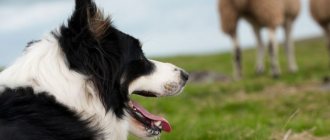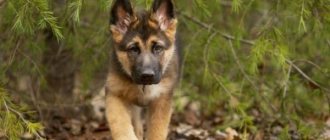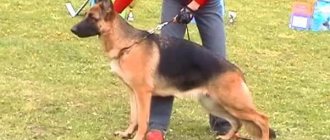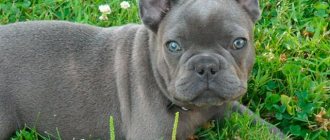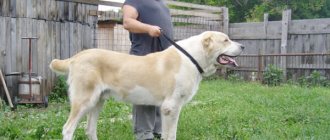| Origin: | France |
| Usage: | universal dog |
| Color: | plain any color except white |
| Dimensions: | 56-68 cm, 30-39 kg |
| Lifespan: | 11 years |
Briard is a versatile pet. The dog adapts to the living conditions of its owners, understands the mood of people, and can handle any work or sports discipline. This is one of the rarest dogs, which was nicknamed hippie for its original shaggy appearance.
Breed standard
The French Briard combines power, harmony and a “hipster” appearance. This is a working dog, but its long coat requires no less care than the coat of decorative dogs.
| Parameter | Description |
| Height | 62-68 cm males, 56-64 cm females. |
| Weight | 30-39 kg. |
| Constitution | Strong, knocked down, but not rough. The muscles are developed, the skin elastically grips the body. |
| Frame | Elongated, slightly longer than tall. The back is straight, sloping down to a strong croup. The neck is cone-shaped, of medium length, and stands high. The chest is deep with rounded ribs. The lower back is convex, the stomach is moderately tucked. |
| Head | Rectangular and long - reaches 40% of the height. It is slightly less wide than it is long. The forehead is convex, the stop is pronounced. |
| Lips | Dry, tightly covering the teeth, black pigmentation. |
| Bite | Scissor-shaped. |
| Ears | They stand high and wide, covered with thick long hair. The ears hang down on the cartilage and rise when excited. They do not lie close to the cheekbones. In Europe, ear cropping is prohibited. In Russia they prefer French Briards with cropped ears. |
| Eyes | Large, round, stand wide. They are covered by overhanging eyebrows. Color – black or rich brown. Gray dogs are allowed eyes that match their color. |
| Nose | Black, square, nostrils well opened. |
| Limbs | Straight, parallel, bones and muscles are developed. Muscle relief is visible on the hind legs. |
| Paws | The pads are strong, collected in a ball, with black claws. Puppies are born with a single dewclaw on the front paws and a double dewclaw on the hind paws. On the front paws the rudimentary toe is docked, on the hind paws it is preserved. Fingers with two phalanges are a distinctive feature of French Shepherds, indicating their ancient origin. |
| Tail | J-shaped, standing low, tapering from tip to tip. Decorated with wavy, long hair. It reaches the hock joints or falls below them by 5 cm. When running, the dog carries its tail in line with the back. |
| Wool | Long, thick, with a slight wave, falling down the sides. Reminds me of a goat. On the body it reaches 15 cm, on the head it is somewhat shorter. The fur forms a parting on the top of the head, on the muzzle there is a beard and eyebrows that partially cover the eyes. |
| Color | Any one color except white. Dark shades are preferred - gray, brownish, black, fawn, red. |
The French Briard moves freely, smoothly, with a cat's step, as if gliding above the ground. This is one of the most beautiful dogs to work with.
Photos will not convey the beauty of the dog’s “gait,” but if you look at him in person, you will certainly fall in love.
Briard character
Briard is not an easy dog. On the one hand, these are affectionate, balanced pets who endlessly love their owner. On the other hand, there are noble manipulators and jealous people.
French Briards love their owner so much that they do not want to share him with anyone else. They compete for his attention with everyone - spouse, children, cats and other dogs.
“Dosed” attention will help: if the dog knows that every day at a certain time they will play and communicate with him, he will become calmer.
Briard Shepherds have expressive facial expressions. They can frown, make a sad face and even flirt like a dog. Once pets understand that their faces touch the owner, they will use them to get what they want or avoid punishment.
The French Briard is active and energetic. He retains a lively temperament into old age. Even a 10-year-old dog is mischievous and frolics like a six-month-old puppy.
The French Briard does not like to be teased. He can misinterpret some children's games and respond with aggression.
Cruel treatment is also excluded. The dog is sensitive, if the owner is rude and lashes out for no reason, the French Briard will be offended. True, he will quickly forgive a person for a tasty treat and affection. But he will forever remember the incident.
The key to the heart of a French Shepherd is to treat him like a partner, a full member of the family. Then the dog will grow up infinitely tender and devoted.
History of the origin of the species
The appearance of this breed dates back to the 12th century. It was from this time that the first written mention of a dog resembling a Briard in appearance dates back to this time. There is also a version that representatives of this breed come from the famous Persian dog.
Close relatives of Briards also include the well-known Beauceron herding dog breed. However, they have little in common, except perhaps their purpose and massiveness. Previously, this breed was often used for looking after animals (especially sheep) and for driving livestock. Therefore, researchers came to the conclusion that Briards were once inhabitants of the wild. This is also indicated by some of the dogs’ habits and the absence in the archives of any data on the artificial breeding of the breed.
Even in the last century, scientists noticed that French Shepherd puppies are born dark and with soft hair, and then gradually lighten and by the age of 3 acquire a stable coat color. This is explained by the fact that Briards have the wound graying gene . This feature does not apply to black puppies; they remain unchanged from the moment they are born.
At the end of the 19th century, when the breed had a standard, these dogs began to rapidly gain fame and take an active part in international exhibitions. At the same time, dogs of this breed appeared at the court of the Russian emperor. However, any breeding work with them was not successful.
Thanks to their excellent character traits, and especially obedience, Briards had the honor of serving at the front (to find wounded soldiers and supply ammunition). Representatives of this breed were once kept by Napoleon and Henry Lafayette.
Application
There is no area in which the Briard Sheepdog does not shine. They are used as:
- shepherds;
- watchmen;
- security guards;
- guides;
- rescuers;
- bloodhound.
But the main calling of the French Briard is to be a companion. He is a sensitive partner, knows how to listen and adapt to the owner.
French Briards can handle any sports discipline. Agility or whitepulling, freestyle or canicross - dogs cope with everything with their inherent ease and equanimity.
Interesting Facts
- A fawn Briard dog named Brutus contributed to the judicial practice of the Middle Ages, acting as a prosecutor at the trial of his master's murderer. The dog fought him, forcing him to admit his guilt. In memory of this event, a stone shield was erected in the city of Montidier.
- During the war, French Shepherd dogs took part in hostilities, carrying the wounded from the battlefield and delivering medicine and ammunition.
- The Briard breed has the same name as the material from which tobacco pipes are made. Briar material (fr. bruyère) is obtained from a tree-like growth between the root and trunk of a shrub of the heather family, sometimes called briar wood. Briard wood has nothing in common with the dog breed, except for the name.
Socialization
The Briard breed is not compatible with other pets. They are too jealous owners. Dogs do not want there to be room in their owner's heart for another animal.
French Shepherds are indifferent to other people's pets as long as the owner does not pay attention to them. All you have to do is pet a St. Bernard, and the Briard will explode with indignation.
French Briards get along with children, but only if they know how to handle the dog. No pulling fur or playing pranks - dogs will not forgive such an attitude.
Briards are cool and wary of strangers. And they always expect a catch. Passers-by should not pet dogs - they will not appreciate familiarity.
It is important that French Briards know how to react correctly to strangers and animals. They are socialized from 3 months. If this is not done, shepherds will grow up to be fearful, withdrawn or aggressive.
Key points in training
Stubbornness and the habit of deciding everything on your own often become an obstacle to training Briards . But those who decide to get a Briard will have to be patient and persevering, because training these dogs is not as easy as it might seem at first glance.
First you need to show the dog who's boss. The main thing here is not to miss the opportunity to become a leader for your pet. Only in this case the training process will seem easy and will bring pleasure not only to the owner, but also to the pet. In this case, harsh methods of influence cannot be used. This can lead to resentment on the part of the pet.
Read about how to properly train a dog in the article: “Training a puppy: effective methods from dog handlers, learning commands at home.”
Thanks to their curiosity and ability to learn quickly, these dogs can be taught any canine sport. These dogs are especially good in such areas as pulk and ski joring.
Raising a Briard
French Briards are smart and quick-witted. They quickly understand what is wanted from them and easily remember complex commands. But training dogs is not easy.
The fact is that the Briard dog breed is authoritarian, aware of its strength, and has its own opinion on everything, including education. Moreover, standard methods of establishing authority with a pet will not work. He doesn't like it when his will is suppressed.
Only affection, praise and treats are used in training. The French Briard will regard even a strict tone as an infringement on the sense of dignity, which is hypertrophied in the breed.
The owner needs to find an approach to a specific puppy. No two French Briards are alike. Which method will work with this particular tomboy is determined by character traits and habits.
If not raised correctly, the French Shepherd will become a vicious, uncontrollable animal.
The first commands are learned from 4 months. At 6-8 months they undergo a general training course (GTC) and a controlled city dog course (UCD). The rest is at the discretion of the owner. French Briards can be trained in any discipline.
Additionally, they develop the sharp mind of dogs. They are taught the daily little things that require thinking. Opening a drawer, bringing slippers or a ringing phone, putting a bowl in the sink - all this keeps French Briards from getting bored.
Feeding
Comprehensive recommendations on this issue can be obtained from your veterinarian. He, having assessed the age, needs and health status of the animal, will be able to recommend the ideal food or nutrition system for this stage. When getting a dog, you need to decide on the animal’s diet. Some people prefer natural food, others industrial food. Both have their positive and negative sides.
Briard - French Shepherd
For example, when choosing a natural method, you know exactly what the dog eats, you are confident in the freshness of these products, and you know that nothing unnecessary has gotten into the food. At the same time, it is not always possible to provide the animal with all the necessary vitamins, minerals and nutrients with such a feeding system. On the other hand, industrial food already contains a full range of useful additives, but who knows what is hidden behind the pressed balls. In any case, contact your veterinarian to select the best option that suits your dog specifically.
Don't overfeed! Excess weight is not good for anyone, especially a Briard at the stage of growing up and developing joints.
Features of maintenance and care
The French Briard dog breed is created for home warmth and comfort. They are kept in a spacious enclosure only in the summer - shepherd dogs are sensitive to cold and dampness.
It is better to have a French Briard in a private home, where the dog can run independently and frolic in the yard. But French shepherds also get along in apartments. The main thing is to take them outside more often, play with them and exercise.
Grooming
French Briards are difficult to care for. They do not shed, but their shaggy fur constantly gets into tangles.
Briard hair is dry, thin, and very tangled. It is prohibited to cut or trim dogs. Therefore, you will have to constantly run around the doggies with combs.
French Briards are groomed as follows:
- spray the fur with a spray for dogs, which makes combing easier;
- gently untangle heavily matted fur with your fingers;
- if the tangles cannot be sorted out, they are cut off with a tangle cutter - but this is a last resort;
- comb the entire coat first with a comb with long, sparse teeth, then with a massage brush;
- mustaches and eyebrows are also combed;
- The bangs on the head are not cut, but if they get into the eyes, they are milled or collected into a topnot.
French Briards are brushed every 8-10 days. The procedure takes 2 hours.
French Briards that do not participate in exhibitions are cut short. This makes grooming easier.
In addition to brushing, Briards need:
- trim the hair between the fingers;
- wipe the ears from wax and dirt, if they are not cropped, thin out the hairs growing in them;
- wipe your face after every meal;
- cleanse eyes;
- remove plaque from teeth with a zoopaste and brush;
- To prevent tartar, give the Briard moslaki or toothpick treats to chew on;
- trim the nails: pay special attention to the nail plates on the dewclaws - as they grow, they bend inward and dig into the skin.
Bathing
The long-haired French Shepherd does not need frequent baths. But washing the briar will take half a day.
How to bathe a French Briard:
- Before the bath, the pet is combed (remember about 2 hours for the procedure);
- soak so that all the wool is wet;
- apply shampoo for long-haired dogs, diluted in a third of a ladle of water;
- thoroughly foam, leave for 5-10 minutes and rinse completely - this is difficult due to the long, thick wool, but you cannot leave even a drop of shampoo;
- Dry the French Shepherd with 8-10 towels and brush again.
A dog living in an enclosure is bathed once every 2-3 months, a city dog - 1-2 times a month, because... their wool becomes contaminated from dust, automobile gases, and factory emissions. You shouldn’t wash French Briards often – this will dry out the skin and cause undercoat loss.
Plus, Briards need high-quality cosmetics. You will have to spend a considerable amount on expensive shampoos, conditioners, rinses, balms, sprays and oils.
Walk
The Briard dog is active and enjoys running and playing. You need to walk your pet 3-4 hours a day, take it out into nature, where the dog can frolic to its heart's content without a leash.
It is important to combine physical and mental activity every day. This is the only way a French Briard will grow up to be a mentally and physiologically healthy dog.
Feeding
French Briards are not picky about their diet. They prefer to be fed natural food - given the size of the fluffy hippie, it will cost less than ready-made food.
There are nuances in feeding:
- feed French Briards 2 hours before or after walking - the breed is prone to gastric volvulus;
- the diet must include vegetable oils, kelp, veterinary supplements with B vitamins, chondoprotectors, biotin, methionine;
- In summer, the calorie content of the diet is reduced - due to the heat, dogs move little and spend less energy;
- From spring to early autumn, dogs are given vitamin E and brewer's yeast.
The coat of French Briards is an indicator of health and nutrition. If it has become dull or matted, possible diseases are ruled out and the diet is normalized.
Characteristics, skills, abilities
According to the current standard, the Briard is a brave, hardy, strong dog with an alert, active behavior and a balanced temperament, neither aggressive nor timid.
The listed qualities do not fully characterize the representatives of this unique breed, which combines universal working qualities, rare intelligence, curiosity, and the ability to learn throughout life.
Best American Bulldog: character
They can draw conclusions, make independent decisions, and analyze any command before executing it.
Briard will not obey unconditionally, and cannot be forced to do anything by harsh treatment or physical punishment. You need to talk to him often and explain the meaning of this or that action, show firmness and consistency in upbringing, and stop unwanted behavior with a harsh tone.
As educational measures, you can ignore the dog, and also refuse to do joint activities and games.
Difficulties in raising dogs of this breed are also due to the fact that Briards are well versed in people, usually know their weaknesses and will always strive to use them.
From a kind and gentle owner, the dog will try to twist the ropes, try to dominate, moreover, treat the owner as the youngest in the pack.
That is why every Briard needs a reputable owner who can earn the respect of his pet and will treat him constructively, devoting a lot of time, patience and attention.
The Briard needs long, regular walks and exercise, runs a lot and stays busy. In addition to physical ones, there must always be intellectual stress: for example, a briard must bring not only a stick or a ball, but also slippers and a newspaper. You can try your pet in agility.
In the absence of sufficient stress, the dog can become lethargic, apathetic and even angry, and begin to perform undesirable actions - damaging furniture, wallpaper and books; she may also develop symptoms of a nervous disorder.
By avoiding mistakes in raising such a dog, you can not only establish contact with it, but also find a reliable protector and faithful friend who will be friendly, obedient and firmly attached to the owner and his family. They will strive to make friends with everyone, will be happy to meet guests and take part in their games and fun.
At the same time, you need to remember that Briards are very jealous and touchy. They are delicate and delicate, so they always need love and attention, affectionate and delicate treatment.
At the same time, these dogs do not tolerate familiar treatment and will never become a toy. They have self-esteem and know their worth.
They consider themselves members of a family to which they are immensely devoted, and will always demand respect for themselves, and if strangers want to pet him, the Briard can show his protest in an unexpected and unwanted form and even bite.
Briards belong to the class of guard herding dogs; they have very strong protective qualities, so the dogs will react to everything that moves and, despite their cheerfulness and sociability, they will always monitor the movements of all family members, not just the owner.
Dogs of this breed are excellent nannies and are capable of not only protecting a child, but also raising him like a puppy, taking on the functions of a teacher.
At the same time, Briards do not like noisy children's games, screams, and to attract order for educational purposes they can bite. Therefore, to adjust their protective qualities, it is advisable to conduct training according to appropriate programs.
Briard Health
The lifespan of French Briards is 10-12 years. Some dogs celebrate their 14th and 15th birthdays.
Diseases
Briard dogs are prone to:
- dysplasia;
- epilepsy;
- volvulus of the intestines and stomach;
- hypothyroidism;
- cancer;
- retinal atrophy;
- hemeralopia;
- allergies are rare.
Most pathologies are hereditary. If a French Briard puppy is adopted from healthy, defect-free parents, it will live a long life without frequent trips to the vet.
Vaccinations
French Briards are vaccinated against:
- plague;
- rabies;
- parainfluenza;
- enteritis;
- herpes;
- coronavirus.
The vaccination schedule is compiled by a veterinarian. Puppies are vaccinated 4 times up to 12 months; adult Briards are given a comprehensive vaccine annually.
They take care of the hair and skin of French Briards. Due to the long thick hair, parasites constantly inhabit the fur coat, which are difficult to detect. Antiparasitic treatment and prevention of helminths every 3 months are indicated.
Mating
The French Briard is formed by the age of 2. Although the first heat in female dogs occurs at 8-10 months, she cannot be mated with a male dog until she is fully mature.
The first signs of pregnancy in a dog are noticeable 1.5 months after mating. It is recommended to do an ultrasound - this will rule out a false pregnancy and allow you to determine the number of babies. Usually 8-10 babies are born.
How to choose a Briard puppy
The breed is small in number. Therefore, their breeding is controlled by briar clubs. Briard puppies from a breeder must:
- have split dewclaws on the hind legs;
- be of medium size - too large or small will not fit into the requirements of the standard;
- do not have an umbilical hernia, pathological discharge from the nose, eyes, ears, or anus;
- be with issued veterinary passports and puppy metrics - they are re-registered for pedigrees up to 15 months of age.
Little puppies resemble strays - their fur will be formed by 6 months. Also, over the course of 3 years, the color changes slightly - it lightens or darkens.
Demands are also put forward to parents. Check availability:
- pedigree - closely related crossing (inbreeding) should be a concern;
- certificate of dysplasia index not lower than B or C;
- a note in the veterinary passport next to the nickname “sel” - selected;
- certificate of IPO-1 system standards - father and mother must have at least 17 points.
Briard Shepherds are an unpopular breed. The risk of getting a defective puppy is minimal - only if the buyer himself wants to buy an inexpensive pet-class kitten. But if the new owner takes a breed or show-class dog, he is obliged to continue breeding - the condition is stated in the purchase and sale agreement. There are only a few French giants, and it would be sacrilege to reduce the already small gene pool.
